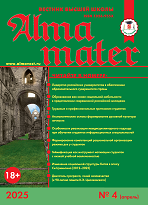UDC 316.6-056.3
https://doi.org/10.20339/AM.10-21.058
N.T. Ibadullaeva is Doctoral Student at Department of Sociology at Baku State University e-mail: nurlana_86@mail.ru
Identified are the essence and indicators of aggression at the level of interpersonal relations in the educational environment of Azerbaijan were identified. The phenomenon of bullying has been found to consist of systematic or temporary physical or psychological violence committed in a group or individually, with an emphasis on a person who is mentally or physically weak. Under the conditions of bullying, high school students develop a stable relationship between the “victim” and the “criminal”. It is shown that the positive attitude of high school students, individual adaptive potential and neuropsychological stability, activity in interpersonal interactions and positive perception of others, reduction of anxiety can be an important condition for the formation of a number of positive psychological characteristics. Aggression is based on a difficult life situation. The most active factors of the viability of such behavior of schoolchildren who are participants in violence in the educational environment have been identified.
Key words: adolescents with disabilities, aggression in everyday life and at school, ways of overcoming.
References
1. Ilham Aliyev took part in the opening of the Youth Center in Masalli, met with representatives of the youth of the region. URL: https://president.az/articles/4478
2. Hussein, E.M. The role of national and moral values in overcoming the deviant behavior of adolescents. Baku, 2015. 24 p.
3. Akhmedova, G.M. Features of the manifestation of antisocial behavior in adolescents in modern conditions and the psychological problems of their regulation. Baku, 2007. 18 p.
4. Akhmedova, E.A. Socio-psychological aspects of destructive behavior: (at the stage of development of high information technologies: Abstract of a candidate's thesis in psychology. Baku, 2005. 17 p.
5. Akhmedova, E.A. Problems of forensic psychological examination of minors in criminal cases. Abstract of Cand. dissertation in psychology. Baku, 2004. 27 p.
6. Alieva, H.I. The role of the teacher-student relationship in the formation of the personality of a teenager: Abstr. Cand. diss. in psychology. Baku, 2007. 23 p.
7. Alieva, S.N. Gender and age characteristics of aggressive behavior in adolescents: Abstr. Cand. diss. in psychology. Baku, 2011. 27 p.
8. Allakhyarova, S.A., Pirieva, E.A. Factors of deviant behavior in adolescents. Deviant human behavior in the modern world: problems and solutions. Materials of the II International Correspondence Scientific and Practical Conference. Vladimir, May 12, 2011. 568 p.
9. Bandura, A. Teenage aggression. Moscow, 2000.
10. Borodkin, F.M., Koryak, N.M. Attention: conflict! Novosibirsk: Science, 1989. 150 p.
11. Gilinsky, Ya.I. Sociology of deviant behavior as a special sociological theory. Sociological research. 1991. No. 4. P. 72–73.
12. Klee, M. Psychology of a teenager. Moscow, 1997.
13. Lane, D.A. School bullying (bullying). Children's and adolescent psychotherapy. St. Petersburg, 2001.
14. Podolsky, A.I., Idobaeva, O.A. Attention: adolescent depression. Moscow, 2004.
15. Psychology of a teenager. A.A. Rean (Ed.). St. Petersburg; Moscow, 2003.
16. Dewey, Cornell, Susan, P. Limber Law and Policy of Bullying at school. May-June 2015. American Psychologist. P. 333–341.
17. Park, S., Na, E.Y., Kim, E. The relationship between on line activity, netiquette and cyberbullying. Children and Youth Services Review. 2014. Vol. 42. P. 74–81.
18. Peter K. Smith, Claire P. Monks. Concepts of bullying: Developmental and cultural aspects. International Journal of Adolescent Medicine and Health. April 2008. No. 20 (22). P. 101–120.
19. Preuss-Lausitz, U. Foerdern ohne Sonderschule. Konzepte und Erfahrungen in der Regelschule. Weinheiem-Basel, 1981.
20. Ullmann, L.P., Krasner, L. A psychological approach to abnormal behavior. Englewood Cliffs, 1969.
21. Melnikova N.V. The essence of the conceptual foundations of deviant. URL: //http://deviatio2010.vlsu.ru
22. Festinger, L. Theory of cognitive dissonance. St. Petersburg, 1999.
23. Rubinstein, S.L. Being and consciousness. On the place of the mental in the universal interconnection of the phenomena of the material world. Academy of Sciences of the USSR, Institute of Philosophy. Moscow: Publishing house of the Academy of Sciences of the USSR, 1957. 328 p.
24. Comprehensive program on the problems of people with disabilities or children with disabilities in the Republic of Azerbaijan. Approved by the Resolution of the Cabinet of Ministers of the Republic of Azerbaijan. 1994. No. 185, dated May 10. URL: http://www.e-qanun.az/framework/14652
25. Distribution of children under 18 years old by age groups and reasons for primary disability. URL: https://www.google.com/search?q=Statistika+komit%C9%99si
26. 65 185 disabled children receive social benefits monthly. URL: http://www.anl.az/down/meqal
27. Project “National Strategy for the Development of Social Services in the Republic of Azerbaijan for 2020–2026”. URL: http: //www.e-social.gov.az












.png)






